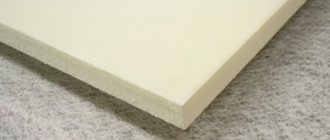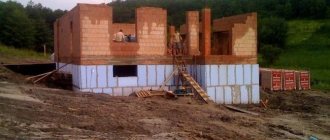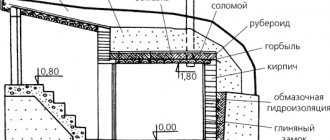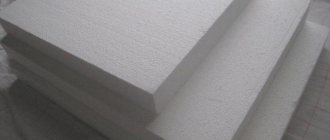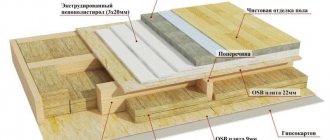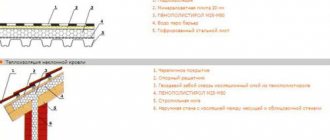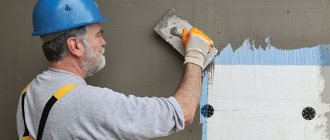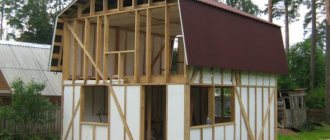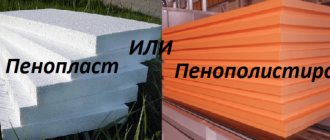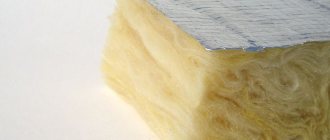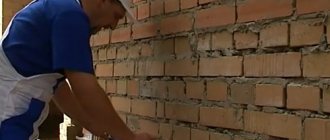Extruded polystyrene foam was obtained as a result of developments in the USA more than half a century ago and in the last 15 years has been widely used for insulating buildings for a wide variety of functional purposes. You can thermally insulate any part of a building with this material - walls, windows, floors, foundations, roofs.
Wall insulation with extruded polystyrene foam can be carried out both from the inside and from the outside. The most acceptable is thermal insulation from the outside, as well as insulation of load-bearing structures during the construction stage. In this case, extruded polystyrene foam is placed in hollow walls.
Extruded polystyrene foam is produced by mixing granules of polymer material (polystyrene) with a foaming agent based on carbon dioxide and light freons.
The composition is heated to a high temperature and pressed through an extruder - a special apparatus that provides better mixing and additional foaming of the entire mixture. This liquid mixture is then formed into sheets. When hardened, they form a durable and lightweight thermal insulation material.
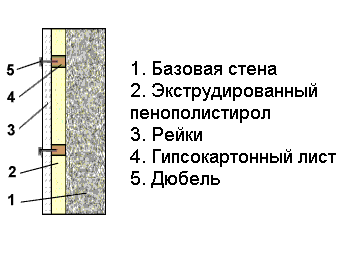
Extruded polystyrene foam is a new word in the field of thermal insulation technologies. Its performance characteristics as insulation are incomparable with those of polystyrene foam, although both are made from polystyrene. Foamed polystyrene has the form of granules measuring 2-8 mm; the material is formed by sintering the granules with each other under the influence of steam. In the case of extruded polystyrene foam, it is not individual granules that undergo transformation, but a single liquid substance.
Therefore, it has a solid, uniform microstructure with unbreakable chemical intermolecular bonds. Consequently, unlike conventional foam, extruded polystyrene foam has a more dense texture, consisting of small (0.1-0.2 mm), completely closed, air-filled cells. The ability to retain heat of extruded polystyrene foam is very high, its thermal conductivity is 0.03 W per cubic centimeter. Such low rates are explained by the fact that the structure of this material contains more than 90% of air enclosed in closed cells. Also, the advantages of extruded polystyrene foam are: High strength - this material can withstand loads of up to 35 tons per square meter. Resistance to aggressive environmental factors – increased atmospheric humidity, temperature changes, active sunlight and so on, as well as damage by insects, rodents, birds. Water resistance, which prevents the occurrence of various types of deformation, the formation of mold and the development of rotting processes. Durability – the service life of this insulation is at least 50 years. Low vapor permeability, which eliminates the need to use vapor barriers during installation. Environmental friendliness - as is known, in addition to widespread use in the construction industry, polystyrene foam is used to make containers for storage and transportation, disposable tableware and even toys. Fire safety.
Pros and cons of foam plastic
The name “foam plastic” is used in everyday life as an abbreviation for expanded polystyrene. This material is designated by the abbreviations PPP or ESP. The first name is in Russian, the second is in English.
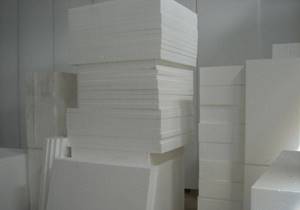
Polyfoam sheet
In the information from manufacturers and sellers of this material there is not a word about its shortcomings. Only the advantages are listed. And this is understandable, since the goal of the manufacturer and distributor is to sell the product, but polystyrene foam has been known to the consumer for more than half a century, and during this period a lot of information has accumulated on the practical use of PPS. This information is not so widely known, but is extremely important for the correct choice of material for facade insulation. There are application features and limitations that you need to be aware of.
The list of advantages of polystyrene foam includes such characteristics as:
- environmental friendliness;
- high-quality sound insulation;
- vapor permeability;
- counteraction to the development of pathogenic microorganisms, due to which fungus and mold do not form in the EPS.

Comparison of insulation materials
Comparative characteristics of thermal insulation materials
The fire safety of polystyrene foam is low, which is the main disadvantage of the material.
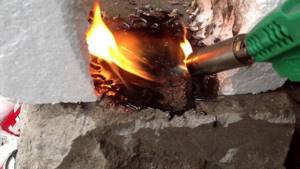
How PSB-S burns
Styrofoam and rodents
The advantages of this heat insulator include the statement that rodents ignore PPS and do not eat its granules as food. That's a moot point. You can find facts for and against.
The practice of using this material suggests that rodents do not eat PPS, but chew it with pleasure. Therefore, the only rational solution is to close the heat insulator as well as possible, that is, to block rodents’ access to it. This is a smart choice for a practical owner.
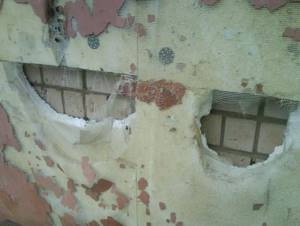
Mice gnawed through the foam
Foam and ultraviolet
Manufacturers of polystyrene foam do not provide information that it is extremely unstable to ultraviolet radiation, and direct exposure to sunlight is especially harmful. The consumer is not informed that this type of radiation negatively affects the chemical stability of EPS and it begins to “age” intensively.
The fact is that polystyrene foam has a polymer structure, therefore, like any other polymer, it will gradually decompose. Ultraviolet light significantly accelerates this process.

Polystyrene foam does not like ultraviolet light
But this disadvantage of expanded polystyrene can be considered relative, since it is not difficult to eliminate the negative effects of UV: it is enough not to expose EPS to direct exposure to the sun. That is, when installing the thermal insulation layer of the facade, the foam must be covered with finishing material as quickly as possible.
About the soundproofing ability of PPS
Claims by PPP distributors that this material is a high-quality sound insulator are questionable. Owners of frame houses who have chosen foam plastic as insulation claim that it has extremely low noise absorption.
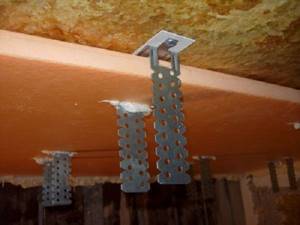
An example of soundproofing a ceiling using penoplex
If you think about it, this fact is quite understandable: more than 90% of PPS consists of air, which is an excellent heat accumulator and an equally excellent conductor of sound. Therefore, you should not hope that polystyrene foam will help reduce the degree of sound permeability of the walls of the house.
As the thickness of the foam blocks increases, the structure's ability to absorb noise increases
About the vapor permeability of foam
The low vapor permeability of expanded polystyrene in practice means that in the path of steam movement from inside the house to the outside, there will be an obstacle in the form of EPS sheets. The temperature outside is often lower than indoors. Therefore, the steam will inevitably condense, as a result of which drops of water will form at the junction of the insulation with the elements of the wall structure. This increases the risk of adjacent materials getting wet.

When deciding what is best to sheathe the outside of the house, do not forget to take into account the vapor permeability of the materials
There is only one way out: correct calculation of the dew point and the required thickness of the insulation, moving the dew point beyond its limits. A reasonable solution is to install a ventilated façade.
It should also be taken into account that the vapor transmission capacity of any heat insulator cannot be considered in isolation from the details of a specific design. It is necessary to take into account what the walls are made of, whether hydro- and vapor barrier is installed, how high the foundation is and other nuances.
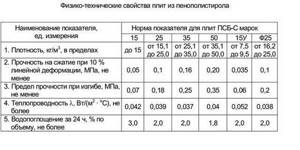
Main characteristics of teaching staff
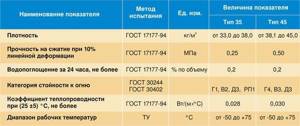
Technical characteristics of extruded polystyrene foam boards
Thermal insulation of hollow walls
Currently, there are methods for constructing hollow walls, which allows significant savings on materials during the construction of buildings. Thanks to the use of sufficiently durable materials, the presence of cavities in the walls does not in any way affect the quality of construction work. In such cases, extruded polystyrene foam is laid directly into the cavity of the load-bearing structures, which significantly increases the performance characteristics of any building - finishing both inside and outside is applied directly to the surface of the walls, and the heat-insulating material lasts much longer, since it is not exposed to the environment and external factors from - lack of contact with them.
If you find an error, please select a piece of text and press Ctrl+Enter.
I like it!1I don't like it!0
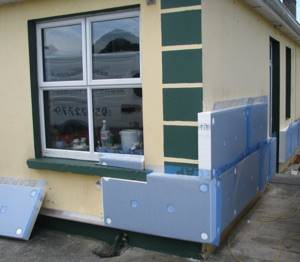
Ask questions in the comments, share your experience, any constructive criticism is also accepted, ready to discuss. Don't forget to share the information you receive with your friends (social buttons above).
You can insulate walls with extruded polystyrene foam with your own hands.
They began to insulate walls with extruded polystyrene foam relatively recently, despite the fact that the material was developed about half a century ago. Today, such insulation is in demand in the construction and reconstruction of buildings of various types, including those with hollow walls.
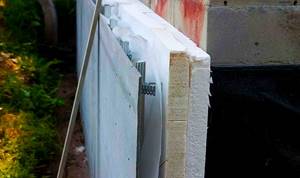
In the latter case, expanded polystyrene is placed inside the wall of the house immediately during construction, thereby reducing its thermal conductivity.
A distinctive feature of expanded polystyrene is the ability to apply it to walls not only outside, but also from inside the house. Which option is preferable is determined in each specific case individually. However, the first one still received the most widespread use.
Preparing the wall and installing the sheathing
Before starting work, it is necessary to prepare the surface of the brick (or other) wall. It is necessary to remove old paint, peeling plaster, and clean from oil stains or other contaminants. Then you should evaluate the quality of the surface and, if necessary, apply a leveling layer of plaster. After it has cured, you can begin installing the sheathing.
IMPORTANT!
The presence of sheathing is not mandatory; it is constructed only for the installation of external sheathing, for example, drywall.
The location of the sheathing bars is perpendicular to the future sheathing strips - for vertically located wall panels (for example), the sheathing is placed horizontally and vice versa. The pitch of the bars corresponds to the size of the insulation boards in order to avoid wasteful loss of material.
The thickness of the bars should correspond to the thickness of the PPS or be slightly larger. It is recommended to coat the bars with an antiseptic to protect against mold or mildew.

Installation of wooden sheathing
Plastering polystyrene foam
Preparation
Before plastering polystyrene foam, it is necessary to prepare the surface.
The work is performed in the following order:
- First of all, you need to make sure that the caps of all dowels are slightly recessed into the surface of the polystyrene foam. If the “umbrellas” stick out, then they should be driven deeper.
- Then you need to blow out all the cracks with a special foam for installing insulation systems. If such foam is not “at hand”, then pieces of insulation can be hammered into the cracks.
- If there are protrusions and irregularities on the surface, they must be erased using a special grater.
- To complete the work, metal perforated corners are glued to the corners and slopes.
Preparation of the solution
After preparing the surface, you should prepare a solution for gluing the reinforcing mesh. Instructions from the manufacturer are included on the packaging.
As for the consistency of the solution, as practice shows, it is more convenient to work with a mixture made a little thinner than the manufacturer recommends. To level the walls, the mixture should be made even more liquid than for gluing, so that it practically flows off the spatula.
Reinforcement fiberglass mesh
Gluing the mesh
The first step in plastering polystyrene foam with your own hands is gluing the fiberglass reinforcing mesh.
The work is carried out as follows:
- Since the mesh is supplied in rolls, it must first be cut into sheets of the required size. It should be taken into account that on the wall it should overlap 10-15 cm.
- Then the mesh fabric is spread over the surface of the wall. For the convenience of further work, it can be “grabbed” with glue in certain places, so that later complete gluing can be done.
- Next, the mesh is completely covered with a 2-3 mm layer of adhesive using a wide spatula. It is advisable to immediately perform this procedure carefully, which will facilitate the alignment of the walls in the future.
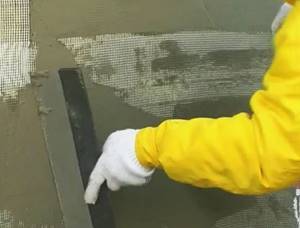
In the photo - gluing the reinforcing mesh
Alignment of walls
After gluing the mesh, a second layer of the same adhesive composition is applied on top of it. After this procedure, it will be completely hidden behind the plaster and the walls will acquire a smooth and even surface.
As mentioned above, the solution should be made more liquid than in the previous case. It is applied with the same wide spatula. The thickness of the layer depends on the quality of the mesh gluing, but on average it is about 3 mm.
Formation of malka texture
Application of decorative plaster
After completing the rough finishing, decorative plaster is applied to the walls.
This is done as follows:
- Before plastering with polystyrene foam finishing composition, it is necessary to treat the surface with a primer.
- Then, after some time, you can begin decorative plastering. The base layer of the composition is applied using a spatula, after which the texture is formed using a small spatula or the same spatula. To do this, the tool performs circular or horizontal reciprocating movements.
- After applying the decorative layer, you should wait for the composition to dry, after which the surface can be covered with facade paint.
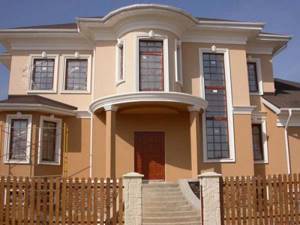
Plastered and painted facade
This completes the plastering process. Now the facade of the building has become not only beautiful, but also protected from negative environmental influences.
Wall Mount
Expanded polystyrene must be firmly fixed to the plane, otherwise the insulation of the walls will be of poor quality. For this purpose, mushroom dowels are used. First, it is better to carry out fastening work in the corners of the slab. This is more reliable, and the load will be distributed evenly over several plates. Only plastic dowels are selected: metal is too susceptible to thermal expansion and can destroy the foam. Metal dowels can cut the material and are not resistant to moisture.
The dowels must be planted to a depth of at least 6 cm. If the insulation has a layer of 8 cm, the dowels must be at least 15 cm in size. The drill is chosen to be 20 cm. It is better to prepare two such tools, since there will be a lot of work, and the safety margin of one of them may simply not be enough.
Foam is a delicate material, so dowels can be inserted into the holes by hand. You can bring them to the level with a rubber hammer. If uneven surfaces appear, it is enough to smooth them out with a solution. At corners and slopes, the distance between the tiles should be from 15 to 30 cm. From the corner they retreat 20 cm along the entire wall, depending on the thickness of the insulation. If its layer is 8 cm, the indentation can be 30 cm.
Final works of facade insulation
Having finished installing the heat insulator, we proceed to finishing the facade with one of the possible materials. These can be plastic profiles, decorative plaster (but in this case you will need to reinforce the surface - that is, fix a mesh on it) or ordinary lining. And the specific actions depend entirely on which material was chosen. If you live in Moscow or the region, then we recommend the guys from KORSGRUP, they know their stuff! https://korsgrup.ru/shtukaturka-fasada
In a word, everyone must decide for themselves how to decorate the insulation - this article only talks about installation technology. If something is still unclear to you, we recommend watching a thematic video about the insulation procedure.
Video - Thermal insulation of facade using polystyrene foam
https://youtube.com/watch?v=449ctrLa-2Q
note
In the image below you can see how to properly fix the disc dowel.
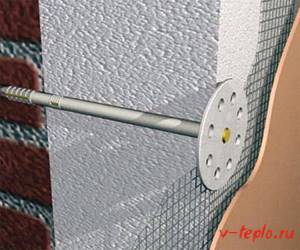
Important point. Plate joints
- After all the disc screws are secured, they must be puttied.
- All sheets of material must be joined to each other exclusively with cut sides: the surface there is more even, therefore, the resulting gaps will be minimal.
- Dowels must be exclusively disc type. They have a special umbrella-shaped cap that reliably presses the insulating material to the surface. Other types of fastening are not as effective, so there is a risk that a strong wind will simply blow the polystyrene sheets off the facade.
- If large gaps form, it is advisable to cover them with thin pieces of polystyrene foam, but certainly not with polyurethane foam. The fact is that the foam will expand the heat insulator and ultimately compromise its integrity.
- All irregularities formed between the joined slabs should be removed with a float.
We do the correct installation of insulation with foil
We advise you to read our guide on how and where to use foil insulation
Technology of laying polystyrene foam in two layers
In some cases, thermal insulation must be more effective. For this we can use two-layer foam. There are some peculiarities here.
- In this case, the first layer should not be puttied. All finishing works are carried out exclusively on the second layer.
- When fixing, we can even do without glue - we take only disc-type dowels, not forgetting to take into account the thickness of two layers at once.
Don't forget the following: try not to get into the place where the dowels are already located, otherwise you will be forced to redo everything, but the previous hole will still remain. This is one of the most important aspects of facade insulation with expanded polystyrene, the technology of which is given here.
Preparation of glue for foam reinforcement
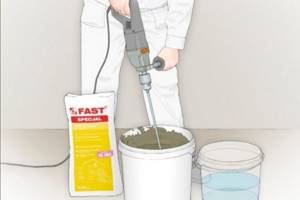
To create a layer reinforced with fiberglass mesh in a polystyrene foam system, it is necessary to use an adhesive solution designed for reinforcing foam boards. The entire contents of the bag should be thoroughly mixed with an appropriate amount of clean water using a low-speed drill equipped with a stirrer. Then the mass should be kept for about 10 minutes and mixed again. It is recommended to periodically stir the solution every 30 minutes. Depending on the temperature, the solution is usable for approximately 2.5 to 3 hours. You cannot add water to the prepared solution in order to “improve” its consistency.
Important nuances
Since creating high-quality and beautiful facades requires a flat surface, the walls must be leveled before attaching the insulation. Protruding parts are removed; in some cases, additional plastering of the building outside may be required in order to achieve the desired result. Differences of 1-2 cm are allowed. This difference can be compensated for by the adhesive composition.
In addition, the following points should be taken into account:
- Fixing with disc dowels can only be done after the glue has completely dried. If they are installed early, there is a possibility that the thermal insulation slab may move to the side or be pressed inward. This will lead to increased consumption of decorative plaster;
- Before attaching the reinforcing mesh, the plastic caps of fungi - umbrellas need to be puttied;
- If there is a need to insulate a house in two or three layers, the sheets are arranged strictly in a checkerboard pattern. Stitches stacked on top of each other are not allowed. Fixation is performed only to the main surface of the load-bearing walls;
- The panels are joined only with cut sides. So, the gap between them will be minimal. The resulting seam is sealed with liquid foam. The use of polyurethane foam is strictly prohibited; its use may lead to peeling of sheets from the surface of the walls and, accordingly, damage to the thermal insulation layer.
useful in work
Installation of the reinforcing mesh and puttying is carried out only on the last layer, on the one located outside the structure. There is no need to process internal ones.
Thermal insulation of walls outside
The most widespread use of expanded polystyrene is for insulating external walls.
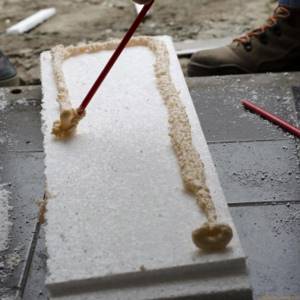
This method is used to insulate buildings during the construction phase, and is also used when reconstructing old buildings. The advantage of this method is that thickening the wall on the outside does not in any way affect the size of the interior space. In addition, insulating walls from the outside is more logical and correct according to the laws of physics.
For external insulation with extruded polystyrene foam, sheets with a thickness of 80-100 mm are used; if thinner sheets of 30-40 mm are used, then they are laid in two layers. This method of thermal insulation allows you to save up to 50% of internal heat and, accordingly, reduce heating costs.
The process of laying insulation sheets is as follows: the surface of the wall is cleaned and leveled, the sheets are glued with a special glue and fixed with mushroom-shaped plastic dowels.

The sheets are laid end to end, but the glue should not get on the joints of the sheets. For better adhesion, the insulation should have a rough surface, and since the extruded polystyrene foam boards are quite smooth, you can make cuts on them with a regular knife before gluing. At the next stage, a layer of adhesive mastic is applied to the polystyrene foam, and a thin reinforcing mesh is embedded into it.
This mesh provides better fixation of the plaster and subsequent finishing. Another leveling layer of mastic is applied to the reinforcing mesh, with a primer mixture on top. Then the finishing façade material is applied or fixed.
It is necessary to take into account that all work on insulating external walls should be carried out at a temperature of at least 5 degrees, in dry weather. Each subsequent layer is applied or fixed only after the previous layer has completely dried.

External thermal insulation of buildings and structures is equally effective in both private and industrial construction.
Classification of expanded polystyrene
Regular foam
The main advantage of the material is the lack of ability to absorb moisture. In addition, it does not rot or biodegrade. Durable material, light weight and easy to use. It can be glued to any building material.
Expanded polystyrene is easy to burn, but it contains a substance called a fire retardant. This is what gives the foam the ability to self-extinguish. In addition, expanded polystyrene cannot be used to insulate facades. This is due to its low vapor permeability. And in order to carry out work with foam plastic under the roof, you should carefully consider the ventilation system.
Use depending on the brand of material
- PSB-S 15. The marking of polystyrene foam indicates that it can be used to insulate structures that are not subject to mechanical stress. For example, insulation of the roof, the space between the slings and the ceiling.
- PSB-S 25 and 25F. Common markings for polystyrene foam. It says that any surface can be insulated. Walls, facades, ceilings or flooring, roofing.
- PSB-S 35 and 50. This material can be used to insulate objects that are under constant high load.
Extruded polystyrene foam
The structure of the material is cellular. And the complete closure of each cell provides absolute protection against water penetration. Therefore, this material is recommended for use where humidity is high or where the material can come into contact with water. This is insulation of the basement or foundation of a cottage. Even in conditions of insufficient waterproofing, extruded polystyrene foam will retain its thermal insulation qualities.
In addition, this material is highly resistant to various deformations. This feature allows it to be used as insulation for surfaces bearing heavy loads. For example, facades can be insulated with extruded polystyrene foam. Especially if the cladding material is very heavy.
As for the temperature. Expanded polystyrene is able to withstand sudden changes, from -120 to +175 degrees. At the same time, its structure remains intact and unharmed.
The disadvantages of this material are flammability, but, like polystyrene foam, its constituent elements can cause it to extinguish. Contact of polystyrene foam with complex carbohydrates can lead to destruction.
Alternative insulation
Also, experts often use polyurethane foam, which, in addition to high-quality insulation, also provides complete insulation from moisture penetration. This material is supplied to the consumer in liquid form, which is sprayed onto the wall using special equipment and reacts with oxygen to harden. The use of an additional layer of vapor barrier is not required. The disadvantage of this method of wall insulation is the high cost of the material and the complexity of the work. In addition to apartments, polyurethane foam is excellent for insulating garages, basements and private houses. To ensure high-quality thermal insulation, it is enough to apply a layer 5 mm thick.
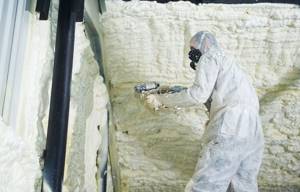
Each of the above materials has a number of advantages, but the big advantage of polystyrene foam is its ease of use, as well as the ability to carry out installation work yourself. To compare extruded polystyrene foam (foam) with other thermal insulators, their performance characteristics are listed in the table below.
| Material | Thermal conductivity coefficient, W/m•K | Vapor permeability coefficient, mg/(m•h•Pa |
| Concrete | 1,75 | 0,03 |
| Expanded clay concrete | 0,9 | 0,09 |
| Clay/silicate brick | 0,81 | 0,11 |
| Foam concrete and aerated concrete | 0,3 | 0,14 |
| Plywood | 0,15 | 0,02 |
| Pine | 0,23 | 0,32 |
| Chipboard and fibreboard | 0,2 | 0,24 |
| Drywall | 0,35 | 0,075 |
| Minvata | 0,45 | 0,3 |
| Glass wool | 0,05 | 0,5 |
| Extruded polystyrene foam | 0,37 | 0,004 |
| Styrofoam | 0,04 | 0,023 |
| Polyurethane foam | 0,03 | 0,05 |
Advantages and disadvantages
The key advantages of polystyrene foam insulation for facade work are considered to be an extremely low thermal conductivity coefficient; in this indicator, the material is second only to polyurethane foam.
The following advantages of Penoplex are also noted:
- high level of moisture resistance. The solution is able to maintain thermal insulation properties even in unfavorable conditions. For example, expanded polystyrene is in demand for underground insulation of foundations, as it is not afraid of contact with wet soil;
- excellent strength characteristics. Penoplex is resistant to mechanical stress, and is easy to cut using ordinary tools;
- expanded polystyrene as insulation for the facade of a house under plaster is inert to biohazards and unattractive to insect pests;
- has a wide operating temperature range, safety margin is designed for 50 freezing/thawing cycles;
- geometric features with clear shapes and the presence of an edge with a locking fastening system make installation easy.
Minuses:
- conditional “non-flammability” as a result of the use of fire retardants at the production stage only provides a reduction in flammability and determines the self-extinguishing properties. At the same time, when penoplex burns, highly toxic compounds are released, which poses a threat to human life and the environment;
- the material is exposed to chemically active substances, contact with which is fraught with destruction of the structure;
- polystyrene foam insulation is afraid of ultraviolet radiation and needs protection, which necessitates plastering work for high-quality thermal insulation of the facade of the house.
A big disadvantage is also the vapor-tightness properties of extruded polystyrene foam when used to insulate facades under plaster. Since there is no vapor permeability, the coating prevents the removal of moisture from the walls. The situation can be partially corrected with the help of internal vapor barrier of wall structures.
Features of insulation of house walls with extruded polystyrene foam from the inside
When it is impossible to carry out work outside the house, wall insulation can be done from the inside.
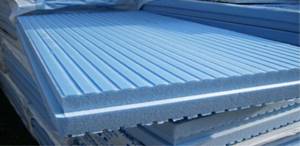
This is typical for the reconstruction of objects of high cultural and historical significance, or when the facade finishing was completed relatively recently. When insulating with extruded polystyrene foam from the inside, it is necessary to purchase sheets with a thickness of no more than 40 mm. Such sheets must be laid in one layer directly on the previously prepared inner surface, using special glue for this.
Considering that the walls are insulated from the inside, additional fixation of the sheets using mushroom-shaped plastic dowels can be abandoned.
Advice! If the outside of the house has not been insulated, then it is worth leaving a gap between the insulation and the surface of the walls.
By insulating the walls of the house with extruded polystyrene foam from the inside, as a result, the area of the house will decrease.
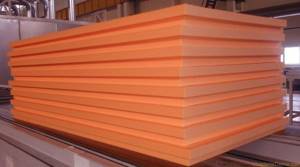
This air gap will act as ventilation. As a result, the penetration of condensate from the outside will be prevented, and therefore excessive humidity and such negative consequences as rotting will be avoided. With such ventilation, the walls of the house will dry out quickly enough.
When performing insulation from the inside, it is worth leaving a ventilation gap between the insulation and the finishing material. However, it is worthwhile to determine the appropriateness of such actions in each specific case.
The presence of such a gap will lead to a significant increase in the thickness of the walls and, as a result, a decrease in the available space. This always happens when insulation is done from the inside.

Considering that insulation with extruded polystyrene foam is done from the inside, the walls are always finished upon completion of the work. To do this, a wooden sheathing is made, to which the selected finishing materials are then attached. Most often, drywall is fixed in this way, which can then be painted, wallpapered, or panels attached.
Although the method of thermal insulation of a house with this material is not the most effective, the demand for it is very high. The increasingly popular insulation of facades with extruded foam plastic compares favorably with many similar materials in terms of price and quality. An additional advantage of its use is easy and quick installation on walls.
Area of use
Ceresit CT 85 has a fairly wide range of applications, which is why consumers purchase this composition, abandoning alternative solutions. This glue can be used to attach plates that are made of polystyrene foam. Their fixation is carried out very effectively. The mixture is suitable for making a reinforcing layer on such slabs when the façade is formed using “wet” technology. This mixture can be used for insulation of new buildings or thermal protection of old buildings. When insulating building facades using the “wet” method using mineral wool slabs, this glue is also used.

Methods for attaching polystyrene foam to the wall
Installation of PPS can be done in the following ways:
- Tight fit between sheathing strips.
- Fastening on special dowels with wide caps - “fungi”.
- Glue installation.
CAREFULLY!
When installing tension between the lathing, there may be cases of broken pieces of material or crumbled areas. These places must be filled with polyurethane foam; gaps or holes should not be allowed. Installation on “fungi” is done in addition to gluing; it is not recommended as an independent method of fastening
Installation on “fungi” is done in addition to gluing; it is not recommended as an independent method of fastening.
Ready-made mixtures are used as glue, which are diluted with water and mixed immediately before installing the material. There are also synthetic types of adhesives produced in cylinders like polyurethane foam, but they are more expensive.
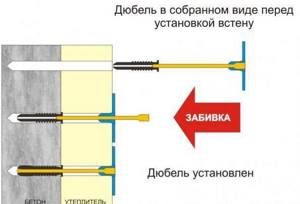
Installation using a dowel
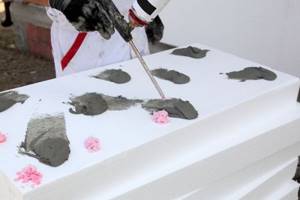
Applying glue
What is the best way to insulate the foundation?
Thermal protection of the base is carried out in 2 cases: directly at the stage of construction of the house and after its completion.
At the same time, experts believe that it is advisable to carry out heat protection measures at the stage of building a house; then it will be more difficult to implement effective insulation. In addition, there are two methods of thermal protection of the foundation base - external and internal.
With internal insulation, it is to some extent possible to insulate an object from negative temperatures. At the same time, condensation still collects between the wall and the heat insulator, which will lead to the destruction of the base, and subsequently to deformation and a decrease in the strength characteristics of the house.
External thermal insulation makes it possible to protect the house and the building materials of the basement from the cold. Because the dew point shifts towards the protective sheet, which is much more stable with respect to moisture and negative temperatures than the base. The end result will be a warm home with an extended service life.
What is extruded polystyrene
This material has been known for a long time, because it was invented more than 60 years ago. Extruded polystyrene foam has become a continuation of the improvement of building and insulating materials. In fact, it is plastic, the difference of which is the presence of a uniform cellular structure. The technology for manufacturing EPP sheets consists of mixing polystyrene granules, carried out under high pressure and temperature conditions, which is accompanied by the addition of a foaming component to the composition.
The latter can be a mixture of light freons and carbon dioxide. Next, the resulting composition begins to be squeezed out of the extruder. The result is a finished product, presented in the form of transparent or colored sheets. Before using it to solve certain problems, the slabs must be dried. Extruded polystyrene is offered for sale in the form of plastic sheets that are constantly exposed to ultraviolet rays. The uniqueness of this product is largely due to its excellent thermal insulation and strength properties, which can be achieved through the use of special technology, as well as a uniform composition and structure, presented in the form of small cells.
Features of EPP
If you try to find out what chemicals are included in the composition of extruded polystyrene foam, you will notice that in this regard it is very similar to polystyrene foam. But this is not surprising, given that both were created on the basis of polystyrene. At the same time, polystyrene foam is not able to compete on equal terms with extruded polystyrene foam in terms of its capabilities. The wide functionality of this material is associated with the peculiarities of the method used for its production. The main difference from polystyrene foam is that an extruder is not used in the production of the latter. However, it is thanks to extrusion that the polymer gains the opportunity to acquire completely new properties.
As the granules melt, they combine with each other, forming a homogeneous viscous mass, as a result of which the raw material gradually begins to acquire a viscous consistency. When passing through subsequent stages of production, this material does not change its state, the stability of which is ensured by unbreakable intermolecular bonds. If we analyze the microstructure of extruded polystyrene foam, it is completely discrete and is presented in the form of cells containing gas inside. Due to the fact that this material has pores, it is resistant to the absorption of steam and moisture. These are precisely the qualities that porous foam does not possess.
Types of insulation material
To insulate buildings from the outside, the following materials can be used:
- Glass wool. This is one of the varieties of mineral wool, similar to it in its production method. Glass wool is not very dense, so it is sold in rolls. The biggest advantage of this material is the fact that rodents and other unpleasant “neighbors” never grow in it.
- Mineral wool. The most valuable advantages of this material are its increased fire resistance (mineral wool is the most fire-resistant material among materials used for thermal insulation) and good sound insulation. Depending on the thickness, mineral wool is produced either in rolls or in slabs.
- Polystyrene foam - this material has much in common with expanded polystyrene, but is still significantly inferior to it in some indicators that are especially important for insulation: it has greater thermal conductivity, is more susceptible to mechanical damage and moisture absorption. You can learn how to insulate a brick house from the outside with polystyrene foam from this article - the insulation method is practically no different from insulation with polystyrene foam.
Advantages of extruded polystyrene foam
One of the most suitable materials for thermal insulation is extruded polystyrene foam (XPS).
This material has good environmental properties; it does not rot and does not absorb water. This material was first obtained in the 40s of the 20th century by the American company Dow Chemical, which was working on a defense order, and in recent years has become widespread in our country. With its help, it is possible to thermally insulate the surface at almost any point from the foundation to the ridge.
What is expanded polystyrene
Expanded polystyrene (EPS) is a material consisting of a mass of gas-filled sealed granules, welded into a single conglomerate during the manufacturing process. In this case, the granules themselves are not destroyed, but are only glued together by their walls.
Depending on the initial size of the granules and the temperature during manufacturing, EPS has different densities and hardness. The finer the grains, the denser the structure and stronger the material. The most important physical property of EPS is its extremely low thermal conductivity: a layer of EPS with a thickness of 3 cm is equal in thermal resistance to a layer of concrete with a thickness of 123 cm.
The following types of expanded polystyrene exist:
- PS. Press.
- PSB. Pressless.
- EPPS. Extruded.
- PSB S. Pressless suspension.
In addition, there are subtypes of material that have a special purpose, for example PSB-S 25F - façade expanded polystyrene with a density of 25.

Material Specifications
The density of the material has a fairly wide range of values depending on the brand.
Samples available with densities:
- PSB-S 15.
- PSB-S 25.
- PSB-S 35.
- PSB-S50, where the last digits are the value in kg/cub.m.
Advantages:
- An excellent heat insulator.
- Effective sound insulator.
- The light weight of the material allows for widespread use.
- Self-extinguishing material (free burning time - 3 seconds).
- It is practically impenetrable to steam and moisture, depending on the density (there is a slight absorption of moisture through capillaries - micro-gaps between welded granules).
- Low price.
Flaws:
- Low plasticity; when deformed, the material crumbles or breaks.
- It does not tolerate contact with solvents such as gasoline, acetone, etc.
- When exposed to flame, it emits large amounts of toxic gases, although in itself it is not dangerous in terms of fire protection.
- It is impermeable to air, which makes it difficult to remove moisture that has seeped through the capillaries.
The capabilities of teaching staff have been tested and confirmed by many years of practice. The material is a leader among other insulation materials due to its low cost, ease of processing and other advantages.
IMPORTANT!
Currently, a new GOST is in force, under which the designations of expanded polystyrene grades look different. For example, PSB-S 25F according to the new standard is designated as PPS-16F.. The chemical basis for all types of polystyrene foam is the same, but the difference in production technology significantly changes their properties
The most different from conventional types are extruded options (EPS, penoplex, etc.)
The chemical basis for all types of polystyrene foam is the same, but the difference in production technology significantly changes their properties. The most different from the usual types are extruded options (EPS, penoplex, etc.).

Comparison of the thickness of materials with the same thermal conductivity
During manufacturing, this material is mixed, causing the structure to change and turn into a homogeneous frozen foam, most similar in appearance to foam rubber, but much more rigid and durable.
EPS is an excellent material for insulation and waterproofing; it is completely impervious to water or steam and is good for working in difficult and difficult conditions - for example, for insulating foundations or other buried structures.
Cost of work on façade insulation with polystyrene foam
Insulation thickness 100 mm. The price is for 1 square meter.
In calculations of the cost of materials, a wet-type façade insulation system is presented. Mineral decorative plaster, grain fraction 2 mm, is indicated as the finishing layer, followed by painting the facade with light-colored façade paint.
| Name of materials | Unit change | Materials | ||
| consumption per 1 sq. m. | Price of materials, rub. | Total materials, rub. | ||
| Tiefgrund LF - base primer | l | 0,30 | 53,83 | 16,15 |
| Insulation PSB-S 25F (facade polystyrene foam), 100 mm | m3 | 0,11 | 3 100,00 | 340,84 |
| Adhesive composition for gluing thermal insulation material | kg | 6,00 | 15,27 | 91,62 |
| Facade dowel “TERMOCLIP” TKS - (8*50*180) | PC | 6,00 | 9,80 | 58,80 |
| Reinforcing composition for reinforcing heat-insulating material | kg | 6,00 | 15,27 | 91,62 |
| Reinforcing fiberglass mesh (alkali-resistant) 4×4 mm | m2 | 1,10 | 40,30 | 44,33 |
| Quarzgrund weiss - primer for plaster | kg | 0,30 | 81,94 | 24,58 |
| Mineral plaster, uniformly rough 2.0 mm | kg | 3,00 | 19,94 | 59,82 |
| Tiefgrund LF - base primer | l | 0,30 | 53,83 | 16,15 |
| Facade paint “Egalisationsfarbe” A – light tone | l | 0,40 | 202,73 | 81,09 |
| _ | ||||
| Additional components, fittings: profiles, reinforcing corners, sealing tape, connecting elements, compensation profiles, etc. | m2 | 95,00 | ||
| In total, the cost of materials per 1 sq.m. | 920,00 |
*prices are as of July 2021.
Technology of laying and fixing polystyrene foam
The time has come to install polystyrene foam on the facade of our house. The procedure is complex and has a number of very important points that should definitely be taken into account before starting work. After all, this is the only way you will be able to ensure excellent thermal insulation characteristics of this material.
We will do this as follows.
Step one. We take a sheet of foam plastic, apply it to the surface of the wall and make holes for the dowels.
Step two. Next, we take a slab coated with glue and apply it to the facade.
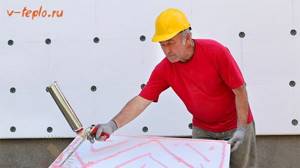
Step three. We place disc-type nails. First, we fix the slab around the perimeter, only after that we press it down in the center.
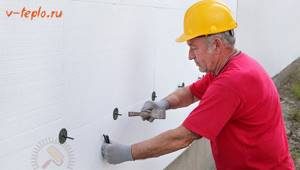
Step four. We fasten all subsequent slabs in the same way. As soon as the first row is ready, we proceed to the second.
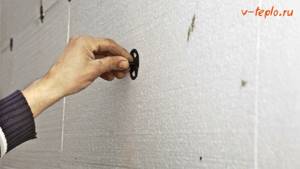
Note! As you work, you need to try to maintain the general level. To check it, you can use a regular mounting level, but it is better to use a laser device, since the error in the first case will still be
Until the glue completely dries, there will be an opportunity to correct something in one place or another.
How is the external walls of a house insulated with polystyrene foam?
Insulation of walls using polystyrene foam is most often done from the outside. This method is possible both at the stage of construction of a new building and during the reconstruction of an old building. The main advantage of insulating the external walls of a house is the fact that when the wall of the area is thickened, the internal space remains the same.
Important! Insulation with expanded polystyrene from the outside is carried out using sheets having a thickness of about 100 mm. If thinner sheets are purchased for thermal insulation of walls, then they should be laid in two layers. This will reduce the heat loss from inside the house by about 50%.
Carrying out thermal insulation work outside the house begins with preparing the surface of the walls.

To do this, the wall is carefully cleaned and leveled. After this, the polystyrene foam sheets are directly glued. To securely fix each sheet, in addition to special glue, mushroom-shaped plastic dowels are also used.
Advice! To ensure the highest quality insulation, the sheets are laid end-to-end. However, the adhesive should not be allowed to get into the joint. In this case, it is worth increasing the surface roughness to increase the adhesion of each sheet, which is initially smooth.
The sheets must be glued in the direction from bottom to top to prevent the sheets from sliding down the wall of the house at the moment when the adhesive mixture dries.
Sheets of extruded polystyrene foam are glued to the wall of the house using an adhesive mixture.
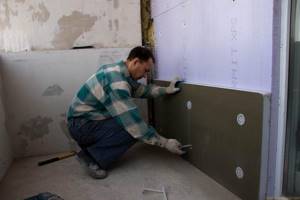
In this case, the amount of shift can be equal to 10 cm. To fix the insulation at the bottom, base profiles are placed in increments of 0.3 m, which will not allow the sheets to move down. In this case, it is worth choosing a base profile that has a width equal to or greater than the thickness of the thermal insulation material.
During the installation process, it is necessary to ensure that the base profile fits tightly to the wall, using special washers for this. To join the ends of the base profile, you must use special connecting elements, leaving a gap of at least 2 mm between them. For corners, you need to prepare a special plinth corner profile.
After gluing the sheets, it is necessary to apply adhesive mastic and embed a thin reinforcing mesh in it, which must be suitable for outdoor work, to increase the rigidity of the applied layer.

As a result, it will be easier to fix the plaster and subsequently finish the walls of the house. After another leveling layer of mastic has been applied, it will be necessary to apply a primer mixture and a finishing compound to improve the appearance of the facade. Thermal insulation of external walls should be done on a day when there is no rain.
In this case, the air temperature should be more than 5 degrees. When insulating a house, you cannot apply the next layer before the previous one has dried. Only then will the work be done efficiently.
Why is the material preferred for thermal insulation?
All structural parts of houses located underground are subject not only to enormous loads, but also to the negative effects of groundwater, acids and other aggressive substances located in the surrounding soil.
It, together with the waterproofing of the object, prevents the building structure of the plinth and base from freezing from destruction by natural water, which expands at subzero temperatures, leading to cracks.
The easiest, most reliable and durable option for thermal insulation of the base is to insulate it with polystyrene foam sheets. They can be installed on a variety of building materials: concrete, brick, reinforced concrete and aerated concrete, both outside the structure and inside.
Advantages and disadvantages
Of course, the lack of analogues for extruded foam makes it a rather indispensable building material. However, do not forget that it is not suitable for everyone. Manufacturing companies today are trying to convince the target audience that these products are universal, but this is far from the case.
Among the advantages of the material are the following:
- high degree of thermal insulation; resistance to strong gusts of wind; waterproofing (in most cases it does not allow moisture to pass through).
All these features put extruded polystyrene foam one step above insulation materials such as mineral or basalt wool.
But, do not forget about its disadvantages. The most important of them is that such building material does not allow the room to “breathe”, that is, it clogs it and can turn it into a stuffy space. Therefore, those who are sure that the room needs such strong insulation should buy extruded polystyrene foam.
The most common mistakes when finishing facades with polystyrene foam
Due to ignoring certain aspects of the work, insulation will not be beneficial. The most common mistakes are:
- A frivolous approach to the preparation process. Foam should only be applied to a flat surface;
- Lack of starting base profile. The bottom bar will help set the level, reduce the load on the bottom layer of insulation, and protect the foam from rodents.
- Installation is not staggered;
- Not using enough dowels.
Insulating a façade with polystyrene foam boards is not a complicated process in terms of manufacturability. To carry out the work you do not need to have special skills. The main thing is a serious approach to each stage. And then the insulation will be as effective and economical as possible.
The most popular manufacturers, packaging price
In Russia there are about a hundred enterprises of varying capacities that produce polystyrene foam insulation boards.
List of popular polystyrene foam manufacturers.
TechnoNikol
Russian manufacturer, its facilities are located in 7 CIS countries and the EU. "TechnoNikol XPS" with a thermal conductivity of 0.028 W/(m*K), is produced in packages of 4 slabs, dimensions 100x580x1180 mm, total area of 2.74 m2, packaging cost - 1200 rubles.
URSA
A product of a Spanish concern, production is also located in Russia in Serpukhov. “URSA XPS G4”, with a thermal conductivity of 0.030 W/(m*K), package of 4 slabs with dimensions 100x600x1180 mm, total area of 2.83 m2, packaging cost - 1500 rubles.
Penoplex
Produced by a company in St. Petersburg. “Penoplex Foundation”, with a thermal conductivity of 0.030 W/(m*K), package of 4 slabs with dimensions 100x585x1185mm, total area of 2.77 m2, package cost 1540 rubles.
Theplex
Nizhny Novgorod plant are produced in the form of slabs. “Teplex 35”, with a thermal conductivity of 0.030 W/(m*K), a package of 4 slabs with dimensions 100x600x1200 mm, a total area of 2.88 m2, packaging cost - 1350 rubles.
Polyspen
The plant is located in Kirov. This is foamed polystyrene, which is produced by extrusion. “Polyspen 35 G4” has a thermal conductivity of 0.028 W/(m*K), the package consists of 7 sheets measuring 50x600x1200 mm, with a total area of 7 m2, the cost of packaging is 950 rubles.
